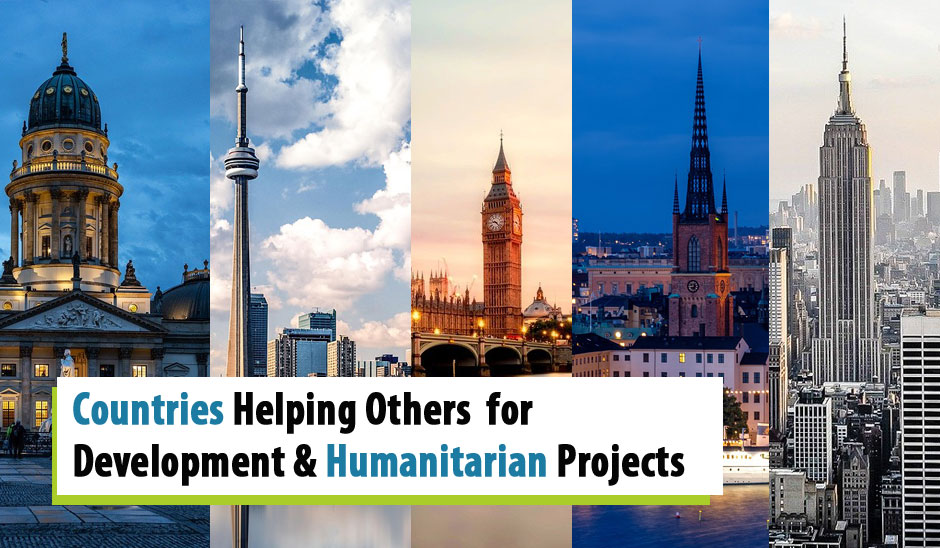Top 10 Countries Helping Others with Foreign Aids for Development and Humanitarian Projects
Last Updated: January 1, 2026
Tweet
Foreign aid is defined as the international transfer of capital, goods, or services from one country to another for the benefit of the recipient country or its people. Aid might be financial, military, or humanitarian in nature. Aids have been acknowledged as significant to helping poor developing countries in their efforts to rise out of poverty. Less developed countries have received aid from developed countries in various forms and for various purposes. Two important objectives, poverty reduction, and institutional quality enhancement are just a few of the many categories that try to increase economic prosperity in recipient countries today.
Please click here to get the complete details on available programs, volunteer’s roles and activities , accommodation, cost, visa , vaccination, airport arrival and the rest of it.
Get More Info Now »
Humanitarian aid is mainly intended to enhance the social well-being and living conditions of people in recipient countries. This might occur in the aftermath of a natural disaster when emergency supplies such as first aid, water, food, and clothes are delivered to the country in need. Organizations may also send volunteer work to assist with the recovery operations, such as healthcare volunteers. Humanitarian aid initiatives are primarily focused on alleviating instant human suffering caused by natural and man-made disastrous events. Humanitarian and Development aid are intertwined, and various kinds of assistance frequently include both humanitarian work and development components.
United States (USA)

The United States spent around $37 billion on foreign aid in 2013. A total of $23 billion is spent each year on humanitarian work for nations that are in crisis across the world. The remaining money is used to fund, volunteer work, and build foreign militaries in countries like Iraq and Afghanistan. After the Second World War, the United States began providing aid to Europe to help rebuild its economy and infrastructure. Hundreds of nations receive US foreign aid, but several stand out as the largest recipients: Middle Eastern countries, global counterterrorism allies, and countries with major global health needs. In terms of its overall funds, the United States often assists countries with GDP, such as Israel.
Please click here to get the complete details on available programs, volunteer’s roles and activities , accommodation, cost, visa , vaccination, airport arrival and the rest of it.
Get More Info Now »
Germany

Germany has been the second-largest donor of official development aid after the United States in 2019. Germany’s international aid has concentrated primarily on issues such as migration, forced assimilation, food security, and climate change. Germany’s foreign aid program strives to bring about long-term transformation in the countries it assists. Germany’s goal is to develop a health system across the world by providing technical and financial assistance. With its core and peace partners, German foreign aid is aiming to build peace and structure. Germany aims to build up nations like Syria, Yemen, and Iraq by intensifying support for individuals in crisis and refugee zones, tackling core causes, and assisting them in the stabilization process.
United Kingdom (UK)
The United Kingdom spent £14.5 billion on assistance last year, making it one of the seven nations to achieve the aim and objectives, according to the Organization for Economic Co-operation and Development. Around £1.4 billion was invested annually on health programs such as medical research, family planning, and disease control. Foreign assistance from the United Kingdom shows that the country has donated billions of pounds to reducing global poverty. Pakistan, Ethiopia, Afghanistan, Yemen, and Nigeria were the top 5 recipients of UK aid, with approximately all of the humanitarian work is going to African and Asian nations. According to data, the United Kingdom spent £1.5 billion on humanitarian assistance in 2019, largely in Yemen, Syria, and Bangladesh.
European Union
The European Union support for poverty eradication in developing countries is primarily focused on economic growth and human development, including the development of social protection systems; however, it also encompasses a wide range of actions addressing poverty drivers in areas such as education, health, infrastructure, good governance, and others, reflecting the integrated nature of the European Union’s methodology. The European Union has increased its financial and policy support for the Global Partnership for Education (GPE), which promotes basic education in the world’s poorest nations while focusing on access and quality. In times of crisis, the European Union is a fervent supporter of education.
Japan
Japan is a worldwide powerhouse as the world’s third-largest economy. In the 1980s, Japan became the world’s leading foreign aid contributor, coinciding with its emergence as an economic powerhouse. Japan’s contribution to international aid is likewise significant, ranking fourth in the world and first in Asia. The future of Japan’s humanitarian works looks bright. In the last five years, Japan’s contributions to poverty reduction and healthcare in Sub-Saharan Africa have continued to expand. It is a major humanitarian contributor as well as a global source of finance and credit. The aid provided by Japan has been critical in enhancing educational equity for women and individuals in rural regions.
France
France is the world’s fifth-largest donor nation. France’s assistance is mostly untethered, and the majority of the initiatives it funds in developing countries are executed by local partners. It has strengthened the predictability of its cooperation as well as the interplay between the three major development authorities. France is determined to work with other donors and the humanitarian community to consolidate its humanitarian works. France may contribute to worldwide environmental preservation, human development and gender equality, economic growth, and peace and stability as a result of this. These improvements, as well as economic development and poverty reduction, benefit countries receiving assistance.
Italy
Italy’s humanitarian budget has more than quadrupled since 2014, reaching USD 266.3 million in 2017, making it the 11th largest DAC humanitarian donor and fulfilling Italy’s 2016 World Humanitarian Summit obligations. In Italy’s policy framework, humanitarian aid is a primary concern. The logistics depot in Brindisi, as well as its associated humanitarian response depot network across the world, provides in-kind donations, volunteer works, as well. Humanitarian aid’s core objectives are to save lives, alleviate suffering, and preserve human dignity. Italy provides humanitarian aid to victims of relief efforts to assist, alleviate suffering, and consolidate human dignity. Italy is dedicated to providing a prompt and efficient response that satisfies local humanitarian relief requirements.
Please click here to get the complete details on available programs, volunteer’s roles and activities , accommodation, cost, visa , vaccination, airport arrival and the rest of it.
Get More Info Now »
Sweden

Sweden has prioritized development in its foreign policy agenda, demonstrating a strong responsibility to foster in effectively addressing global issues. Sweden has a reputation in the international world for being a charitable country, donating generously to developing countries for several reasons. Sweden’s foreign aid is aimed at assisting developing nations in achieving long-term prosperity and volunteering underprivileged people chances to support themselves, whether via employment or the establishment of local firms. Sweden’s contribution is divided over several nations, topics, and programs. Sweden’s excellent assistance rankings are due in large part to its high per capita ODA commitment, with the country committing to $1 billion each year.
Canada

Canada has been one of several countries to come forward to tackle the epidemic during this time when global health is practically an inevitable concern. Over the last 30 years, Canada’s foreign aid has also aided in the elimination of worldwide poverty. Canada also utilizes aid to guide worldwide disarmament efforts as a leader. Some of Canada’s international aid work is being carried out at home, with the contribution of refugees from Iraq and Syria. Not only has Canada contributed to the worldwide fight against the virus by decreasing case counts in its own country, but it has also provided financing to vital health organizations and countries.
Australia
Australia’s worldwide standing was shaped by its contributions of foreign aid to developing nations. The Australian government can promptly provide humanitarian aid to crisis-stricken countries. While Australia contributes to the international humanitarian system by complying with global rules and principles, it also provides a unique strategy that is adaptive, flexible, and primarily focused on resilience development. The primary goals are to improve education and health, gender equality, agriculture, and economic growth so that developing countries can trade and compete on a global scale. As a humanitarian response, Australia assists individuals in the region who’ve been suffering from extreme poverty. To increase regional security, Australian aid focuses on building government and providing necessities to all populations.
Conclusion: Countries helping and supporting others for humanitarian projects
To summarize, industrialized nations have completed the development process, whereas developing countries are still in the process. Foreign aid is generally donated to underdeveloped countries because they cannot develop on their own. They might use the fund for any major development initiative or alleviate poverty in the country. These developing countries seek foreign assistance to help them carry out their initiatives. Foreign aid is mostly provided by developed nations and organizations. Many developments efforts in developing countries are aided by foreign aid. These might aid in the improvement of such a country's global standing. Foreign volunteering can also help to eliminate hunger and speed up the industrialization of developing countries. International assistance, on the other hand, might be a barrier.
Please click here to get the complete details on available programs, volunteer’s roles and activities , accommodation, cost, visa , vaccination, airport arrival and the rest of it.
Get More Info Now »
Obtaining foreign aid has both perks and downsides. Foreign aid should mostly be in the forms of loans, with each loan’s allocation thoroughly supervised. When granted in the form of loans, countries will work hard to return the debt while prospering in the meanwhile. There is usually a sign of progress when foreign aid arrives. Foreign aid, on the other end, should be utilized extremely wisely and cautiously; only then will we be able to eradicate poverty, hunger, and other global issues. The majority of the impoverished lose their economic independence. Misuse by developing countries and political limitations imposed by donor nations are difficult concerns that must be resolved as soon as possible.
If you are reading our information about top countries helping with foreign aid, you must be someone interested about world philanthropy and humanity. If you also want to be part of such initiatives, there are different humanitarian volunteer works that you can join.
Published on January 22, 2022
Frequently Asked Questions (FAQs)
What Country Gives the Most Aid?
The United States , by contributing almost USD 35 billion, gives the foreign aid the most.
What country gives the most humanitarian aid?
USA, Germany, UK, EU , Japan, France, Italy, Sweden, Canada and Australia give the humanitarian aids the most.
What countries give humanitarian aid?
Every country in the world are giving humanitarian aid to each other. The nature of the aid might differ, so might the quantity . But in this global family each country is supporting the other to some extent.
Please click here to get the complete details on available programs, volunteer’s roles and activities , accommodation, cost, visa , vaccination, airport arrival and the rest of it.
Get More Info Now »



